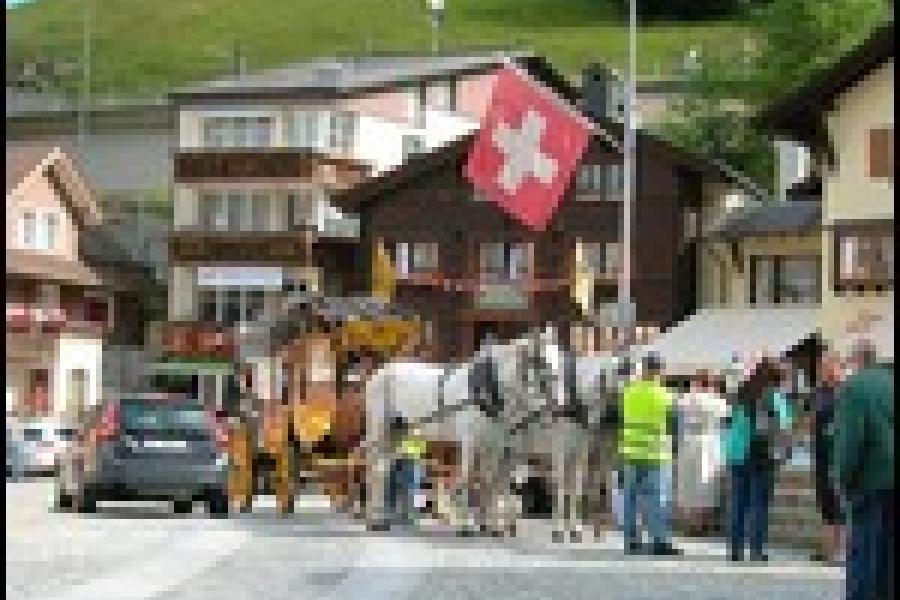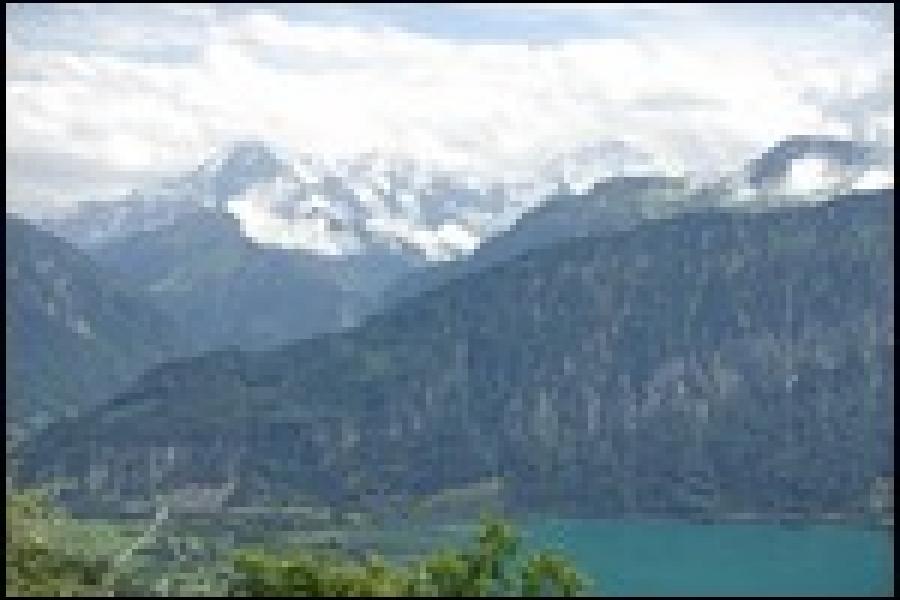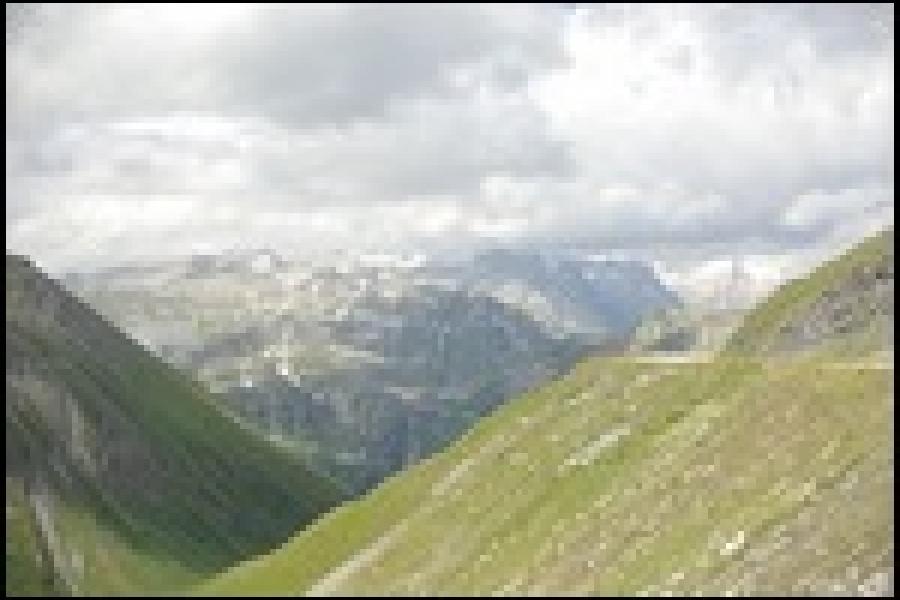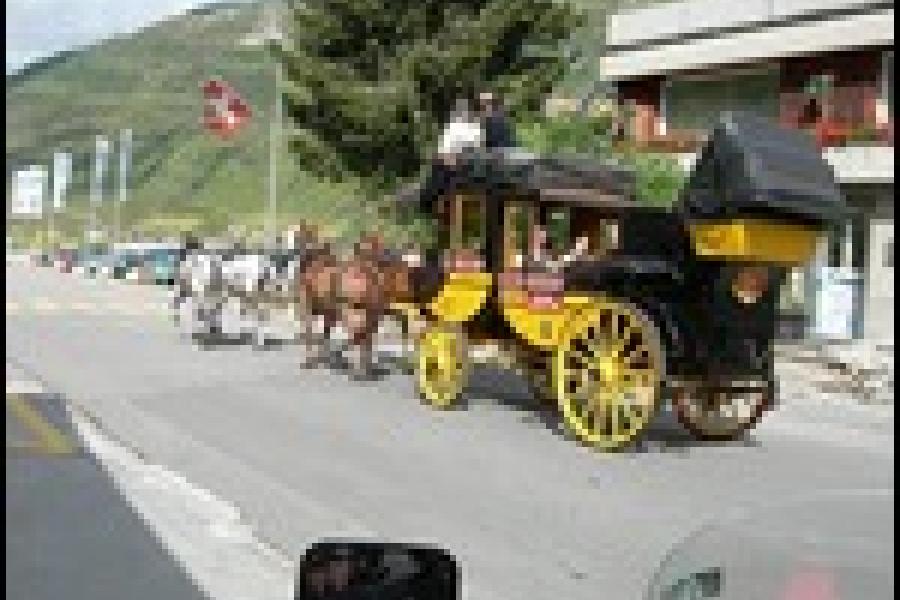Two Passes, Two Rivers, Two Cultures (This blog was originally posted in July 2011 on the Travelpod site)
Country
By the time we crossed into Switzerland we found ourselves running to a deadline for the first time in a few weeks. We had arranged to meet our daughter, son-in-law and granddaughter in western Switzerland for a few days and we needed to be at the place in three days. This was plenty of time provided the weather remained good. Our schedule would allow us to have a day in St. Moritz on the way.
Like holiday places everywhere, St. Moritz has a range of accommodation and it's not all ritzy hotels and restaurants. We found a place to park and were just having a late lunch of quiche when a fellow saw the bike and struck up a conversation. Apart from being a mine of great information about St. Moritz and this part of Switzerland, he gave us one piece of critical intelligence; foul weather was due overnight and would last two days. When Jo told him our plans his advice was simple, we should use the eight hours of daylight remaining to make some distance.
Within a few minutes we had made the necessary decision, fired-up Just Sue and let out of St. Moritz for the mountains. Within a half an hour we were climbing into Julier Pass hustling along the narrow roads, slipping by the locals on their way home from work. Our aim was one of the small towns between St. Moritz and the central Swiss town of Andermatt. The weather threatened and we rode through some light showers and the road was wet, damp, dry then wet again but all the time the storm heads threatened in the west.
At about 1800 hrs, we stopped for a navigation check. The weather was holding, we had plenty of fuel and plenty of daylight. We decided to go all the way to Andermatt and give ourselves a day's grace in case the weather did turn bad in that unpleasant alpine way. The trouble with this plan was that we would have to ride the Oberalp Pass on the way into Andermatt. The Oberalp is one of the best sweeper roads and late in a long day, fully laden on a damp road would not be the best way to experience it.
Forty minutes later we were climbing on the pass road. From the east the approach was typical of others we had ridden up over the preceding weeks but once we crossed through the pass and started the long run down to Andermatt the road settled into a series of smooth arcs, never straightening and seldom tightening to the extent that would necessitate a gear change. Even on a damp road we flew along and even though tired after riding more than half way across Switzerland on lousy roads, it was good fun.
The second last sweeper short of Andermatt ran downhill into a tunnel then, halfway through in the half light, tightened significantly. We leaned a little further and swept through comfortably but I glanced at the outside wall and the evidence of others who had been caught out. The last sweeper ended at the town and we rolled out of the corner and into the drive of a hotel already host to a dozen bikes. While Jo organised a room another biker led me to the garage and helped me to get Just Sue inside. As Jo came out to help unpack the luggage the storm arrived with a crash of thunderous rain.
The rain continued all night but, to our amazement, stopped with the dawn and by the time we were packed the sky was blue and the road dry. We entertained ourselves with the automatic payment arrangements at the unmanned service station then headed for Furka Pass and the road to Interlaken.
The Furka was interesting because it is here that the Rhone Glacier feeds its waters into the Rhone River which flows south to the Mediterranean at Marseille. A few kilometres back, all of the water had flowed to the north, into the Rhine River and all the way to the North Sea. The Furka Pass is at the watershed of two of Europe's great rivers. To the south, Mediterranean Europe, olives and the sun. To the north, the plains of Central Europe, root vegetables and bitter winters.
Beyond the Furka Pass we stopped at the village of Meiringen, which is close to Reichenbach Falls, and were surprised to find a statue of the fictional detective Sherlock Holmes in the main square. It seems that the Reichenbach Falls was the place in 1891 where Holmes was done-in by the dastardly Professor Moriarty. The town has made something of a celebration of the fictional event. We noticed Baker Street and Conan Doyle Place while driving around. If you are a Sherlock Holmes buff it is worth a visit because the statue, created in 1988 by John Doubleday, has hidden in it clues to 66 Holmes mysteries. The greatest mystery of all, however, is how the monument came to be erected by the “Norwegian Explorers of Minnesota”. We have no idea what the Minnesota Norwegians were doing in Meiringen, but I'm sure the answer is out there somewhere!
We had an easy day into Interlaken, looked the place over then elected to stay in a small village in the hills 600 metres above the Thuner See with an uninterrupted view of the Eiger, the Monch and the Jungfrau. We had a classic Swiss dinner of rosti and sausages, then the next morning we rode down to a little village above Montreux, a meeting with our family and a week off. Team Elephant was travelling well, but looking forward to the break.























